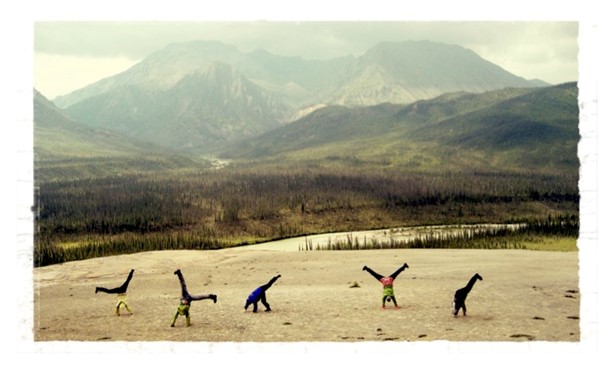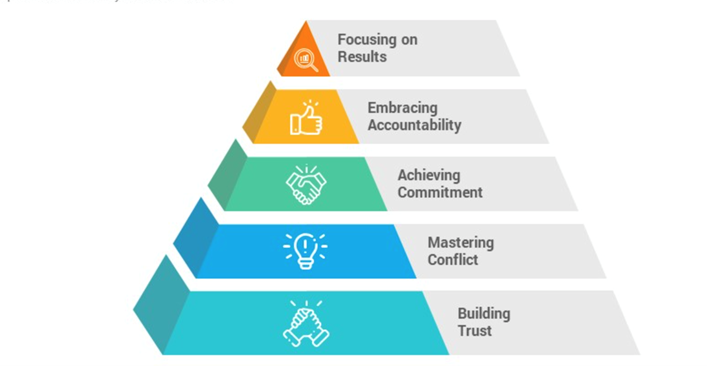By: Kat Smithhammer
Teams with clear direction, an aligned culture, commitment to the mission and goals bring organizational success, yet forming and sustaining a cohesive team can be one of the more complex challenges facing any leader and team member.

5 Team Behaviors for Cohesion
Patrick Lencioni advocates for a simple model of cultivating five specific team behaviors (the five layers of the pyramid below) ensuring team performance and cohesion. He believes teams that trust one another are capable of holding diverse perspectives and can engage in robust debate. By doing so, they can deeply vet ideas and ensure commitment to their best decisions. Teams committed to their decisions with agreed-upon standards hold themselves accountable and cultivate the ability to openly confront their peers about staying on course and correcting if needed. Thus, a team that trusts, engages in healthy conflict, commits to and is accountable for decisions can also set aside individual wants and departmental agendas for the purpose of the collective team and organizational results.
It sounds simple - tend to each layer of the pyramid, starting with the base, and the orange pinnacle of focused results will be reached. Yet, in practice it is not so simplistic. I think of this model as a framework that I can lean on and ask, “which layer, or combination of layers, of the pyramid need tending to in this particular context to move action forward?”

A pause may seem like a moment of hesitation, or a delay of action, and you may feel judged or self-conscious about it, however starting with the ability to pause and reflect is critical. I firmly support Divine and Hunt’s belief that team members will be recognized for their ability to be reflective, calm, unhurried and see possibilities of action within the fray. It begins with taking a breath, reflecting on the current patterns of team behaviors (the big picture view) and also checking-in with yourself (“do my emotions have me right now, or do I have them?”).
The forms of reflection identified above will help in discerning a possible course of action. Achieving this may require stepping out of the content of the conversation and tending to the relationship by clarifying your purpose and reassuring positive intent. It may take disclosing that your is attention is split and admitting you aren’t fully present. Perhaps you realize you made a mistake and you openly take ownership with your team. You may need to point out that the team has repeated the same concept three times now and the volume is getting louder, so perhaps you will need to ask, “what hasn’t been heard or acknowledged?” You may need to highlight accountability by asking, “are our commitments not being met because we didn’t buy into the decision in the first place?”
A common human approach is to work harder if results aren’t being met. Sometimes this does the trick, but as a follow-up I ask, “how long is that approach sustainable?” Task achievement and team process (culture of how the work get done) are both efforts that need attention, in different amounts, possibly at different times and with flexibility. Similar to the layers of the pyramid, these things need to be practiced, tended to, assessed and readjusted.
Relaunch the team
A team of individuals working together is a complex system, and every time you add or lose a member of the team, the dynamics change. These transitions of team membership are ideally met with intention. I think of them as an opportunity for a relaunch of the team. Whether you are launching a team from the start or relaunching a team, do so with forethought and a plan. Be specific about who is on the team and who is not, clarify and align the team’s purpose and goals, know how and what type decisions will get made, explicitly name the desired team culture (norms, agreements), disclose communication style preferences openly and honestly (fast to action, moderately paced and methodical, lead with logic or a focus on people). Acknowledge that conflict will occur and discuss how the team will ideally navigate conflict - not in detail, but in principal. For example, “we’ll be open to each other views by listening and asking curious questions. We will spend time clarifying our larger interest and then discuss tactics and positions, etc.” Hackman, a former Harvard team researcher, wisely stated that early team events persist, thus approach launches with care. It doesn’t mean you can’t change team culture once it’s established, but it’s a lot harder later. Intervene early and often to build the strong foundations of trust and culture.
Practicing Lencioni’s five behaviors will support team performance, if your team members can readily put these behaviors into action. There is something rewarding in the immediate gratification of helping someone try a new approach, a new strategy, resource or recommendation. However, this rarely leads to sustainable change. Lasting transformation requires curiously questioning beliefs that fuel behaviors. When we unlock our underlying assumptions and competing interests and become conscious of our worries, we can then understand why behaviors are enacted as they are and what purposes they serve. When beliefs shift, behaviors follow and we can develop new ways of being and seeing. Possibilities open up with the ability to pause as a team member and as a team. Become aware of your inner motivations and drivers, observe patterns of team behavior, keep results in mind and be willing to stop action in the moment to unearth assumptions and competing interests. Understanding tacit beliefs allow teams to bring about new results and meaningful change that can be sustained over time.
For more learning
Divine, L. & Hunt, J. (2021). The power of a pause. ICC Integral Coaching Canada. Retrieved from https://www.integralcoachingcanada.com/sites/default/files/pdf/powerofpause.pdf
Kegan, R. & Lahey, L. (2009). Immunity to Change: how to overcome it and unlock the potential in yourself and your organization. Boston, MA: Harvard Business School Publishing Company
Lencioni, P. (2005). Overcoming the five dysfunctions of a team: a field guide for leaders, manager, and facilitators. San Francisco, CA: Jossey-Bass
Wall, C. L. (2004). The courage to trust: a guide to building deep and lasting relationships. Oakland, CA: New Harbinger Publications, Inc.
About the Author

Kat Smithhammer approaches life with curiosity, creativity and awe. Often laughing (at times referred to as a “katcophony”) and smiling, she is fascinated with the growth and development of individuals, teams and organizations.
In 2010, she co-founded Leadership at Play, in service of developing leadership capacity and interpersonal dynamics through an ethic of play. She’s had the opportunity to work with a variety of audiences – from NASA Shuttle Crews, to Federal Land Managers to Googlers and non-profit Executive Directors.
Leadership at Play helps build resilient leaders and teams. We believe that an organization is at its best when people understand and apply their highest potential. Our role is to identify and grow that potential.
By partnering with us, you develop a team that better understands and supports your organizational goals, has stronger decision-making skills, handles conflict openly, and is grounded in trusting relationships. In turn, your organization runs more effectively, and sustainably, and achieves your desired results.